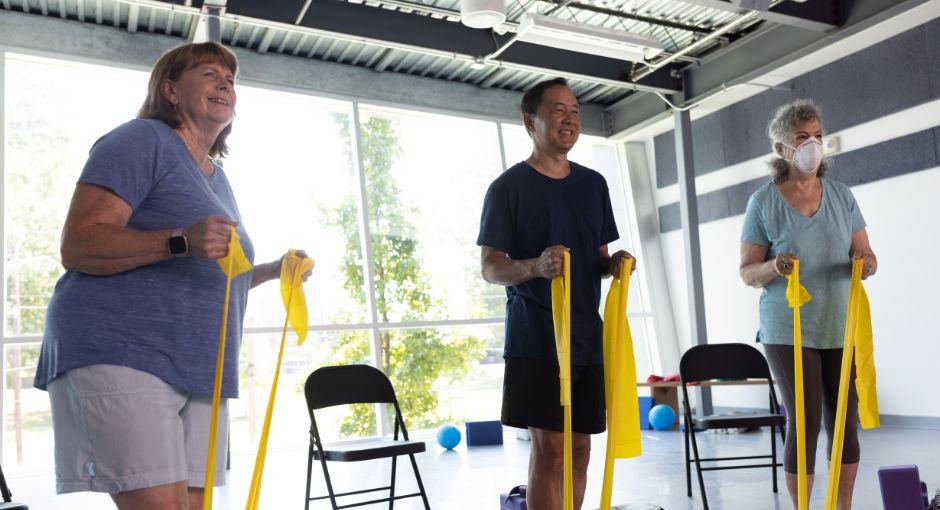Exercise

Exercise is an important part of healthy living for everyone. For those with Parkinson’s disease (PD), exercise is more than healthy — it is a vital component to maintaining balance, mobility and activities of daily living. Research shows that exercise and physical activity can not only maintain and improve mobility, flexibility and balance but also ease non-motor PD symptoms such as depression or constipation.
The Parkinson’s Outcomes Project shows that people with PD who start exercising earlier in their disease course for a minimum of 2.5 hours per week experience a slowed decline in quality of life compared to those who start later. Establishing early exercise habits is essential to overall disease management.
What type of exercise should I do?
To help manage the symptoms of PD, your exercise program should include these key components:
- Aerobic Activity
- Strength Training
- Balance, Agility & Multitasking
- Flexibility
The Parkinson's Foundation, in collaboration with the American College of Sports Medicine, created new Parkinson’s disease exercise recommendations to provide people with PD safe and effective exercise programs and instruction.
The exercise guidelines include recommended frequency, intensity, time, type, volume and progression of exercises that are safe and effective for people with PD. Each recommendation is paired with specific types of activity and special safety considerations for people with PD.
Recommendations are available in multiple languages.
The four elements of exercises are included in many types of exercise. Biking, running, Tai Chi, yoga, Pilates, dance, weight training, non-contact boxing, qi gong and more are included — all have positive effects on PD symptoms.
What kinds of exercise programs are available?
Many programs can help focus on improvements in functional capacity and mobility. These programs vary according to different aspects of physical training. Examples of PD exercise programs include:
- Intensive sports training (non-contact boxing classes)
- Treadmill training with body weight support
- Resistance training
- Aerobic exercise
- Alternative forms of exercise (yoga)
- Home-based exercise (YouTube videos or PD Health @ Home Fitness Fridays)
- Stretching
There is no “exercise prescription” that is right for every person with PD. The type of exercise you do depends on your symptoms and challenges. For those who may be more sedentary, starting with low intensity exercise, such as walking, is beneficial. This can be increased to regular, more vigorous activity as tolerated.
The most important thing is to do the exercise regularly. We suggest finding an exercise you enjoy and can stick with!
How To Get Started
- First, be safe. Before starting an exercise program, see a physical therapist specializing in PD for full functional evaluation and recommendations.
- Use a pedometer (step-counter) and figure out how many steps you take on average each day, then build up from there. Many smartphones or smartwatches have a built-in pedometer feature or an application that can be downloaded.
- Exercise indoors and outdoors. Change your routine to stay interested and motivated.
- Most importantly, pick an exercise you enjoy.
Find Local PD Exercise Classes
Across the country, dance classes and boxing groups designed specifically for people with PD are growing in popularity. Contact our Helpline at 1-800-4PD-INFO (1-800-473-4636) or Helpline@parkinson.org to find one near you.
Working Out with a Partner
Many people find that they achieve the most success when exercising with a partner. Depending on the stage of the disease, it may be best for people with PD to train in an environment where others who could offer help are available if needed.
A workout partners can help motivate and engage one another in their exercise. People new to exercise programs may benefit with training with an individual or group leader. A physical therapist may be helpful in starting a program for people whose mobility is significantly affected by PD.
Exercise Tips
- The best way to see benefits is to exercise on a consistent basis. People with PD enrolled in exercise programs with durations longer than six months, regardless of exercise intensity, showed significant gains in functional balance and mobility as compared to two-week or 10-week programs.
- When it comes to exercise and PD, greater intensity may have greater benefits. Experts recommend that people with PD, particularly young-onset or those in the early stages, exercise with intensity for as long as possible as often as possible. The more you do, the more you benefit.
- Intense exercise is exercise that raises your heart rate and makes you breathe heavily. Studies have focused on running and bicycle riding, but experts feel that other intense exercise such as swimming should provide the same benefit.
- Regardless of your condition, always stretch, warm up and cool down properly.
- Exercise in a way that is safe for you. Know your limits.
- Many support groups, therapists and exercise programs can help with PD-safe exercises or help you set up your own program.
Challenges to Exercising
People in the early stages of PD tend to be just as strong and physically fit as healthy individuals of the same age. As Parkinson’s progresses, it can lead to the following physical changes:
- Loss of joint flexibility, which can affect balance.
- Decreased muscle strength or deconditioning which can affect walking and the ability to stand up from sitting.
- Decline in cardiovascular conditioning, which affects endurance.

The Parkinson’s Outcomes Project study shows that 2.5 hours of weekly exercise along with medication, can significantly improve quality of life for people living with Parkinson's.
Exercise & Parkinson’s Research
Exercise is good for the heart and the muscles, but exercise can actually change the brain. Establishing early exercise habits is an essential part of overall disease management, which is why neurologists now recommend exercise as part of most PD treatment plans.
People with Parkinson’s who engaged in at least 2.5 hours of exercise a week had a better quality of life than those who didn't exercise at all or started exercising later.
Research finding from the Parkinson's Outcomes Project, the largest-ever clinical study of Parkinson’sNeuroprotective Benefits of Exercise
Neuroprotection is when your brain works to prevent the death of neurons, or brain cells. For people with PD, exercise is not only vital to maintaining balance, mobility and daily living activities, but it has the potential to have a neuroprotective effect.
The Parkinson’s Foundation studied exercise as part of our Parkinson's Outcomes Project study. Our Center of Excellence network believes that exercise is important to good outcomes in PD, and data supports that. Exercising enhances the sense of wellbeing, even across different disease stages and severities.
Contact our Helpline
Monday - Friday from 9 a.m. to 7 p.m. ET. in English and Spanish
Page reviewed by Dr. Chauncey Spears, Clinical Assistant Professor at the University of Michigan.
Related Materials
Related Blog Posts

New Exercise Recommendations for the Parkinson’s Community and Exercise Professionals

Addressing Exercise Standards for Fitness Professionals Working with the Parkinson’s Community
